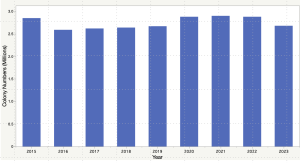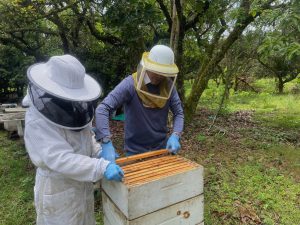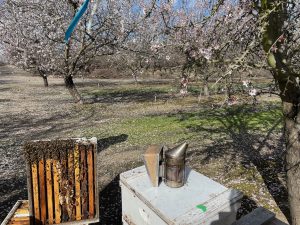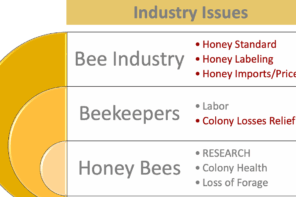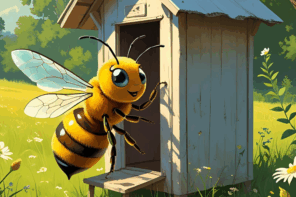Click Here if you listened. We’d love to know what you think. There is even a spot for feedback!
Read along below!
Found in Translation
Colony Turnover, The Big Picture
By: Jay Evans, USDA Beltsville Bee Lab
Last month, I focused from inside the box on the beauty and productivity of honey bee colonies, and the parts that must work together to keep things buzzing. Now it’s time to look down (sometimes literally, in the form of satellites) at U.S. bee colonies and see what we can glean from a distance. It is well known that honey bee colonies fail at a substantial rate each year. In the past nine years of data from the USDA’s great National Agricultural Statistics Service Honey Bee Colony Report (https://www.nass.usda.gov/Surveys/Guide_to_NASS_Surveys/Bee_and_Honey/), losses have remained stubbornly constant. From 2015 to 2023, colony losses averaged an astronomical 53% per year. Even in the best year (2023) losses were 46%, imputed from the first half of the year (watch the NASS site for the latest data each August). 1.5 million lost colonies each year represents a lot of bees and anguish. Fortunately, beekeepers have fought back against these losses, and the net colony numbers for that same period have not changed much at all (see figure 1), holding steady at 2.75 million colonies/year when recording beekeepers with five or more colonies. This has been an expensive battle but has allowed bees to continue to play huge roles in agriculture and economies from the backyard to the largest farms. A recent paper by Kirti Rajagopalan and colleagues from Washington State University and USDA (including longtime honey bee health researcher Gloria deGrandi-Hoffman) has pulled together a classic colony growth and prosperity model for honey bees (VARROAPOP) with current and future climate trends to give a truly unique view of how and why the elements can interact with disease and nutrition to impact bee health (Rajagopalan, K.; DeGrandi-Hoffman, G.; Pruett, M.; Jones, V.P.; Corby-Harris, V.; Pireaud, J.; Curry, R.; Hopkins, B.; Northfield, T.D. Warmer Autumns and Winters could reduce honey bee overwintering survival with potential risks for pollination services. Scientific Reports 2024, 14, 5410, doi:10.1038/s41598-024-55327-8). One of the takeaways, perhaps familiar to those keeping bees in much of the U.S., is that mild weather is not always a great thing for bees. By showing the impacts of longer, warmer Fall seasons the authors demonstrate that bees prepping for Winter do better when the switch comes quickly than when those bees are induced to spend another month out looking for declining forage. Surprisingly, an early Spring is not always a good thing either, partly because no one loves Spring as much as the small population of overwintering Varroa mites. There is a lot to ponder in this paper. The results apply from Tulsa to Toledo and for beekeepers considering all the options for holding their bees over Winter.
Is the U.S. unique in these challenges? Not entirely. Honey bee colony losses have been trending higher in much of the world. In the first ever survey of Latin America, led by Fabrice Requier and the SOLATINA group of researchers (https://solatina.org/), and now available as a reprint at https://doi.org/10.21203/rs.3.rs-3378800/v1 (First large-scale study reveals important losses of honey bee and stingless bee colonies in Latin America), annual losses across multiple countries and years were 30%. Colombia had losses of 50%, near those of the U.S., and generally losses were higher in more temperate parts of South America than in southern Mexico and Central America. Mexico had annual losses below 20%, the lowest value for countries sampled in two years. To our North, losses in Canada were similar to in the U.S., 32% over the 2022-23 Winter, and 45% over the prior Winter (https://capabees.com/capa-statement-on-honey-bees/). These losses were not spread equally, with lower losses in coastal provinces and in Quebec than in Ontario and Alberta. It would be really interesting to see how Canadian losses map against the predictions of the colony loss model.
So, are there signs of good news? Yes, for sure. For bees living in Europe, the Middle East or New Zealand, Winter mortality remains close to the historical U.S. norms of 10%. Alison Gray from Glasgow, Scotland, and a large team of experts compiled data for 37 countries, biased towards European members of the Colony Loss Network (www.COLOSS.org) in their 2023 paper “Honey bee colony loss rates in 37 countries using the COLOSS survey for Winter 2019–2020: the combined effects of operation size, migration and queen replacement”, in the Journal of Apicultural Research (https://www.tandfonline.com/doi/full/10.1080/00218839.2022.2113329). Values for most countries were right near the average, despite a huge range of climates and management intensities, with only Spain showing mortality greater than 20% (25.3%, still well below the U.S. and Canada).
Even in the U.S., I find solace that losses were not consistent across all places (i.e., yay, Montana, whose ca. 40,000 colonies in apiaries of five or more had losses between one and 5% for each quarter of 2022 and 2023, impressive!). And we know from beekeepers that losses are patchy, with some consistently dodging whatever bullets are flying and many who go years without pain before drawing a bad hand. There are answers out there, even when the overall numbers are grim and the answers aren’t obvious. In short, the details in these reports, alongside experimental studies, provide plenty of food for thought for U.S. researchers and beekeepers. Maybe there is something different happening overseas that we can emulate, from bee management or regulation to breeds of bees. It does give one hope that we need not accept high bee losses and the stresses they put on beekeepers and agriculture.
As the modelers at the start of this essay show, it might be complex but there has to be a way to get back to more level beekeeping. This is not to shame those who have had losses, I have known many of them for years and they are extremely focused beekeepers. It could be that we won’t escape the curse of colony losses much of the time (we certainly don’t with our research colonies), but one has to hope there are management or breeding solutions to stop some of the curses and cursing. I am not one to think AI will solve the world’s problems right away, but maybe someone can have it chew away on the nut of “why did those bees die?”, using the vast stores of public data coming out from surveys (thanks beekeepers) and environmental data. Meanwhile, enjoy your bees and don’t take them for granted.







